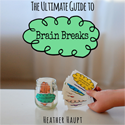Have you ever had those days when you’re trying to school your children and they get that glazed-over look? You can tell that their focus is elsewhere. They may be looking at you and sitting still, but they for sure are not hearing anything you say!
As we began the process of getting our oldest evaluated, I learned about Sensory issues. I had never heard about Sensory problems before. During the process of educating myself on sensory issues, ADHD and aspergers, I learned about movement and how it really helped kiddos like mine. However, finding what really worked and how to implement it was a whole different story. I was really short on time and coming up with my own sensory diet was hard and a lot of work. We plugged along and as time has continued on, my oldest and my middle have improved. Yet, there are times when I know they are off in a land of their own during school time. So I began to research again. It was around this time that I heard about The Ultimate Guide to Brain Breaks.
What is the Ultimate Guide to Brain Breaks?
Brain Breaks are intentional movement activities that work to wake up the brain. This stimulates the brain, causing it to focus and pay attention again. Its like giving the brain a reboot (pg 4 of The Ultimate Guide to Brain Breaks).
Why does movement matter?
Our society is set up so that kids are encouraged and required to spend large chunks of their days sitting in chairs. We want them to sit still, pay attention, and learn (pg 5 of The Ultimate Guide to Brain Breaks).
Movement helps the two hemispheres of the brain work together. This, in turn, MAKES LEARNING EASIER! (pg 7 of The Ultimate Guide to Brain Breaks).
There is so much in this book. Heather really goes into the science of why movement is so important, yet she keeps it easy for any person to understand. She also keeps it brief enough that even us busy moms can read it and learn to apply it:). She also goes over the activities so that you know exactly what to have your child do and how to do it. One thing I LOVE about this book is that most of the activities require no supplies at all! You know how it is, you’re all set to start an activity only to learn you can’t because you have none of the supplies you need!!! I loved how I could read through this book and immediately begin to implement the strategies.
If you have a child that has ANY of the following happen when sitting for very long, check out this wonderful resource:
1. Eyes glaze over and they won’t focus
2. Their mouth hangs open
3. They start to get disruptive
4. They start to get over-emotional
5. They ask questions that have nothing to do with the task at hand.
6. They stare out the window
7. They become listless-taking FOREVER to accomplish a task.
8. They fidget constantly but without making headway.

One other thing I wanted to add, this resource is not just for kids who are homeschooled. It is also a wonderful addition for teachers in school, church, or anywhere else where sitting is required!
In CHRIST,
Laura from raisingsoldiers4christ

No comments:
Post a Comment